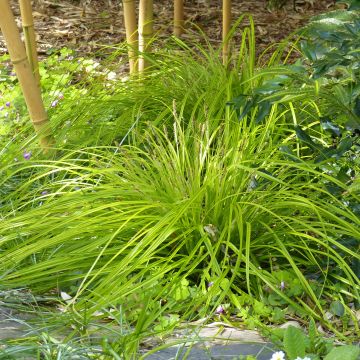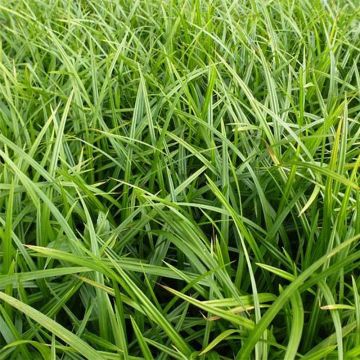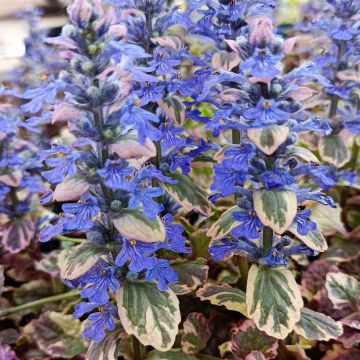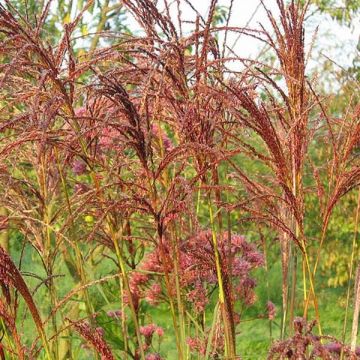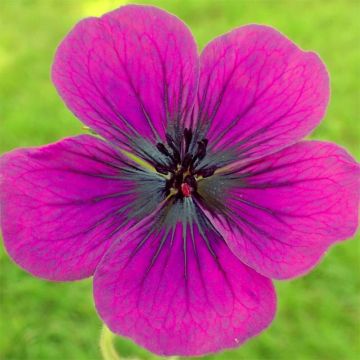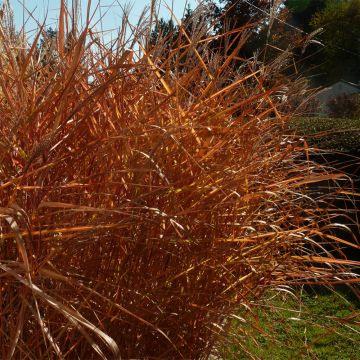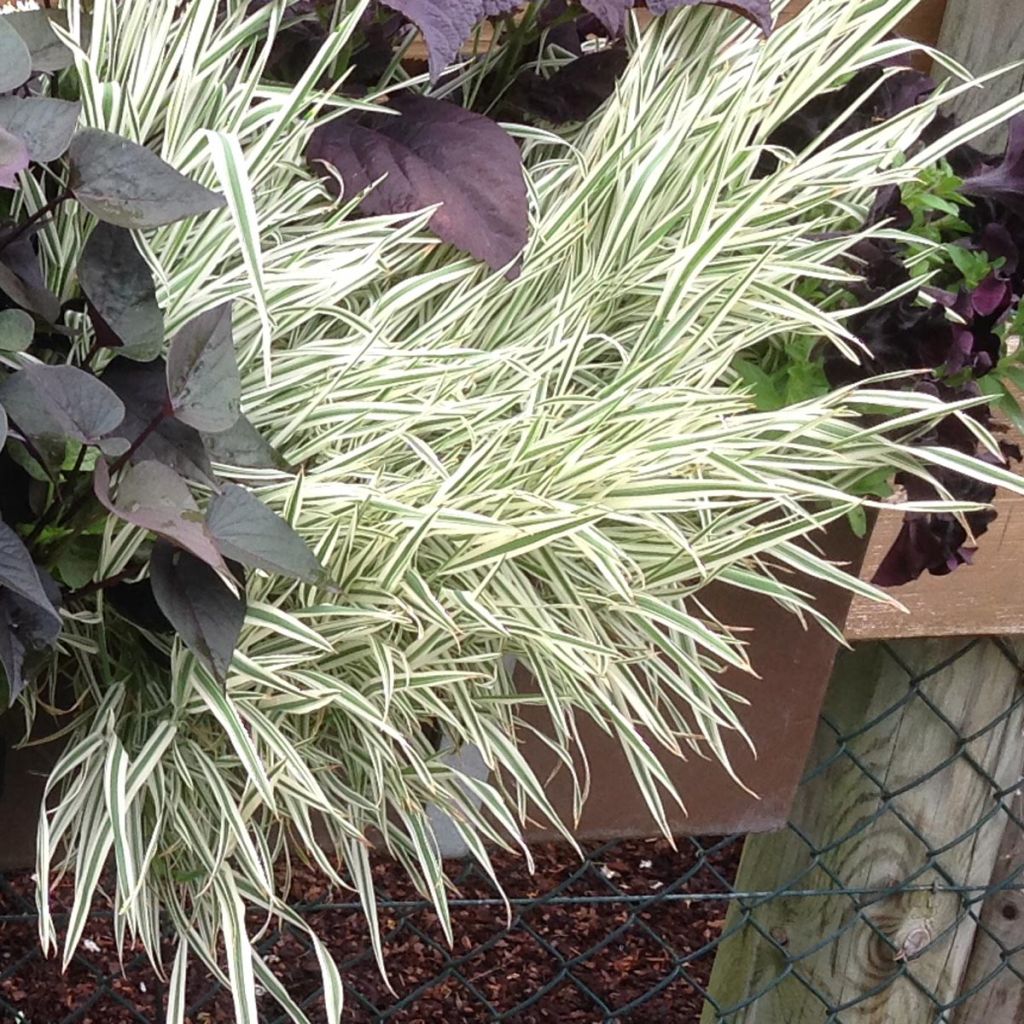

Phalaris arundinacea - Reed Canary Grass
Phalaris arundinacea - Reed Canary Grass
Phalaris arundinacea Cote de Nacre
Reed Canary Grass
Why not try an alternative variety in stock?
View all →This plant carries a 12 months recovery warranty
More information
We guarantee the quality of our plants for a full growing cycle, and will replace at our expense any plant that fails to recover under normal climatic and planting conditions.
From €5.90 for pickup delivery and €6.90 for home delivery
Express home delivery from €8.90.
Does this plant fit my garden?
Set up your Plantfit profile →
Description
Phalaris arundinacea 'Cote de Nacre', also known as False Reed Canary Grass, is a perennial rhizomatous plant found on riverbanks or pond edges. It is a small grass with ribbon-like leaves vertically striped with white, which leans towards pink. It resembles reeds, with its spreading tufted habit, and displays large feathery flower heads from spring to summer. This plant can add a unique touch of verticality to perennial borders, garden beds, and hanging baskets. It is both radiant and possesses a wild and refined charm, renewing the genus. Adding it to your garden will bring a lot of originality and verticality to your perennial beds, flower pots and hanging planters.
Phalaris arundinacea 'Cote de Nacre' is a variegated plant belonging to the family Poaceae (formerly known as grasses). It is found in Europe, Asia, North Africa, and North America. This ribbon-like plant can grow up to 50 cm (19.7 in) tall and covers an infinite ground surface. It has beautiful foliage that is radiant and refined, blending the colours green, white, and very pale pink. From June to September, it forms small clumps of narrow basal leaves, which give rise to slender, erect stems that can reach heights of 120 to 150 cm (59.1 in). These stems are topped with feathery heads of tiny flowers that turn silver when mature. Its flowers form an elongated paniculate 5-25 cm long. They branch and spread during flowering, then turn pale greenish-white to purplish. The aboveground part of the plant is green, while its black rhizomes are long and creeping, making it capable of penetrating tough soils.
The 'Cote de Nacre' False Reed Canary Grass is a fully hardy plant that can thrive in any garden soil that doesn't dry out in summer. It can be planted in both full sun and partial shade. Although it prefers moist soil, it can tolerate long periods of drought. This compact variety can be easily planted alongside annual or perennial plants in garden beds or large hanging baskets. You can leave the faded flower heads in place, which will add charm to the winter landscape around ponds or can be used as dried bouquets.
Report an error about the product description
Flowering
Foliage
Plant habit
Safety measures
Botanical data
Phalaris
arundinacea
Cote de Nacre
Poaceae
Reed Canary Grass
Cultivar or hybrid
atteinterespiratoire
Cette plante peut entraîner des symptômes allergiques.
Evitez de la planter si vous ou vos proches souffrez de rhinite saisonnière ("rhume des foins").
Davantage d'informations sur https://plantes-risque.info
Other Perennials A to Z
Planting and care
Phalaris arundinacea 'Cote de Nacre' is fully hardy. It thrives in any garden soil that doesn't dry out in summer. It can be planted in full sun or part shade. It thrives in base- and nutrient-rich soil with a neutral to slightly acid pH. Despite its predilection for damp soils, this plant can withstand long periods of drought. Plant the rhizome in moist, unsubmerged soil or even in mud, submerged under 30 cm (11.8 in) of water. To prevent this plant from becoming invasive, it can be placed in 34 cm (13.4 in) x 35 cm (13.8 in) baskets, partially submerged. Cut back wilted inflorescences, or leave them in place, as they will add charm to your pond's winter decor.
Planting period
Intended location
Care
-
, onOrder confirmed
Reply from on Promesse de fleurs
Ornamental grasses
Haven't found what you were looking for?
Hardiness is the lowest winter temperature a plant can endure without suffering serious damage or even dying. However, hardiness is affected by location (a sheltered area, such as a patio), protection (winter cover) and soil type (hardiness is improved by well-drained soil).

Photo Sharing Terms & Conditions
In order to encourage gardeners to interact and share their experiences, Promesse de fleurs offers various media enabling content to be uploaded onto its Site - in particular via the ‘Photo sharing’ module.
The User agrees to refrain from:
- Posting any content that is illegal, prejudicial, insulting, racist, inciteful to hatred, revisionist, contrary to public decency, that infringes on privacy or on the privacy rights of third parties, in particular the publicity rights of persons and goods, intellectual property rights, or the right to privacy.
- Submitting content on behalf of a third party;
- Impersonate the identity of a third party and/or publish any personal information about a third party;
In general, the User undertakes to refrain from any unethical behaviour.
All Content (in particular text, comments, files, images, photos, videos, creative works, etc.), which may be subject to property or intellectual property rights, image or other private rights, shall remain the property of the User, subject to the limited rights granted by the terms of the licence granted by Promesse de fleurs as stated below. Users are at liberty to publish or not to publish such Content on the Site, notably via the ‘Photo Sharing’ facility, and accept that this Content shall be made public and freely accessible, notably on the Internet.
Users further acknowledge, undertake to have ,and guarantee that they hold all necessary rights and permissions to publish such material on the Site, in particular with regard to the legislation in force pertaining to any privacy, property, intellectual property, image, or contractual rights, or rights of any other nature. By publishing such Content on the Site, Users acknowledge accepting full liability as publishers of the Content within the meaning of the law, and grant Promesse de fleurs, free of charge, an inclusive, worldwide licence for the said Content for the entire duration of its publication, including all reproduction, representation, up/downloading, displaying, performing, transmission, and storage rights.
Users also grant permission for their name to be linked to the Content and accept that this link may not always be made available.
By engaging in posting material, Users consent to their Content becoming automatically accessible on the Internet, in particular on other sites and/or blogs and/or web pages of the Promesse de fleurs site, including in particular social pages and the Promesse de fleurs catalogue.
Users may secure the removal of entrusted content free of charge by issuing a simple request via our contact form.
The flowering period indicated on our website applies to countries and regions located in USDA zone 8 (France, the United Kingdom, Ireland, the Netherlands, etc.)
It will vary according to where you live:
- In zones 9 to 10 (Italy, Spain, Greece, etc.), flowering will occur about 2 to 4 weeks earlier.
- In zones 6 to 7 (Germany, Poland, Slovenia, and lower mountainous regions), flowering will be delayed by 2 to 3 weeks.
- In zone 5 (Central Europe, Scandinavia), blooming will be delayed by 3 to 5 weeks.
In temperate climates, pruning of spring-flowering shrubs (forsythia, spireas, etc.) should be done just after flowering.
Pruning of summer-flowering shrubs (Indian Lilac, Perovskia, etc.) can be done in winter or spring.
In cold regions as well as with frost-sensitive plants, avoid pruning too early when severe frosts may still occur.
The planting period indicated on our website applies to countries and regions located in USDA zone 8 (France, United Kingdom, Ireland, Netherlands).
It will vary according to where you live:
- In Mediterranean zones (Marseille, Madrid, Milan, etc.), autumn and winter are the best planting periods.
- In continental zones (Strasbourg, Munich, Vienna, etc.), delay planting by 2 to 3 weeks in spring and bring it forward by 2 to 4 weeks in autumn.
- In mountainous regions (the Alps, Pyrenees, Carpathians, etc.), it is best to plant in late spring (May-June) or late summer (August-September).
The harvesting period indicated on our website applies to countries and regions in USDA zone 8 (France, England, Ireland, the Netherlands).
In colder areas (Scandinavia, Poland, Austria...) fruit and vegetable harvests are likely to be delayed by 3-4 weeks.
In warmer areas (Italy, Spain, Greece, etc.), harvesting will probably take place earlier, depending on weather conditions.
The sowing periods indicated on our website apply to countries and regions within USDA Zone 8 (France, UK, Ireland, Netherlands).
In colder areas (Scandinavia, Poland, Austria...), delay any outdoor sowing by 3-4 weeks, or sow under glass.
In warmer climes (Italy, Spain, Greece, etc.), bring outdoor sowing forward by a few weeks.




































